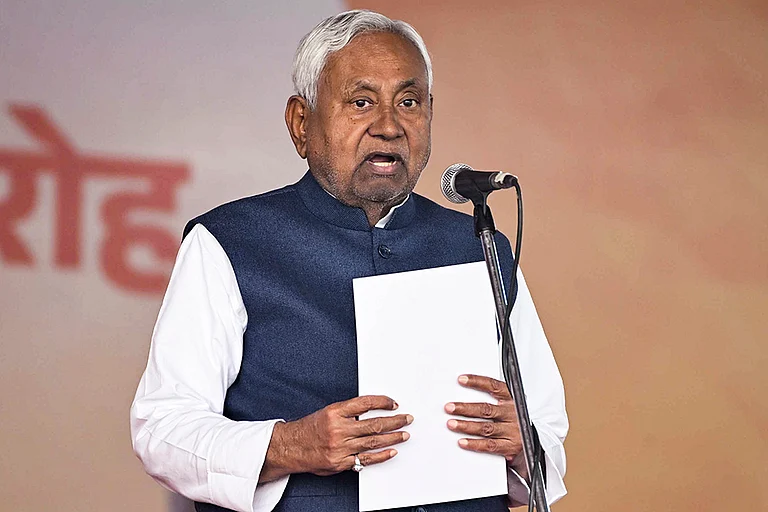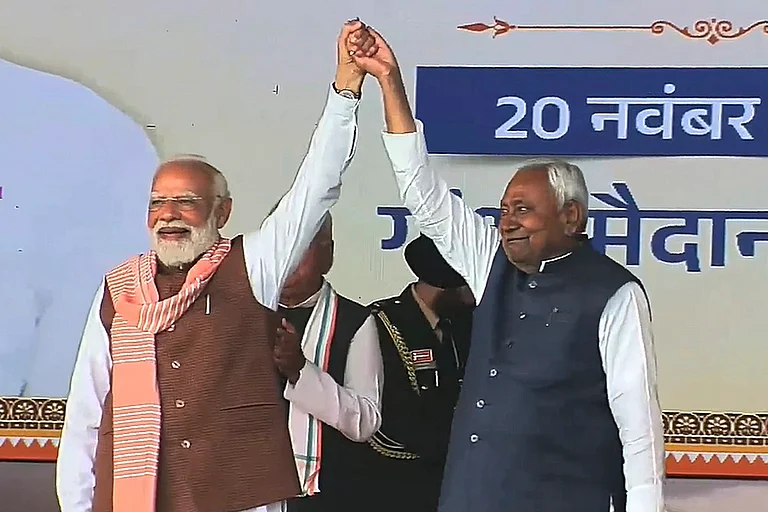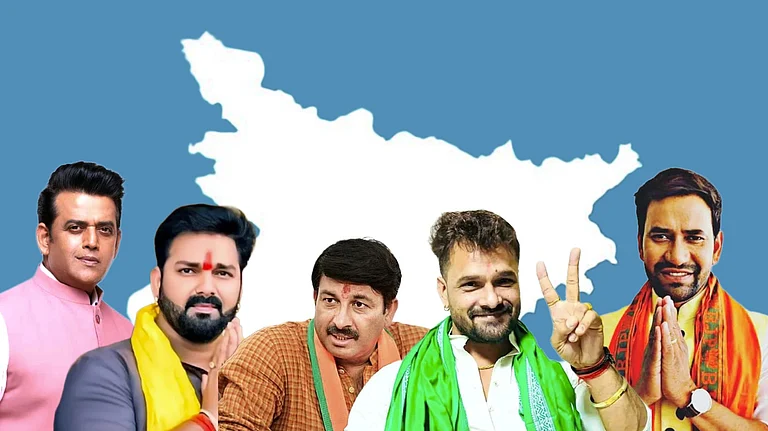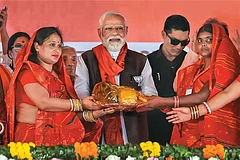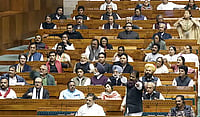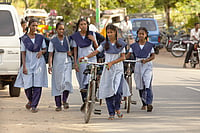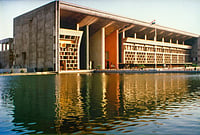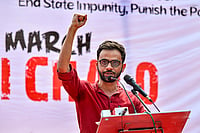
Bihar elections today are at the sharp end of a high-stakes contest in which every party has welfare as its central pitch.
Down south, building on a legacy of anti-Brahminical social justice movements, Tamil Nadu and Kerala institutionalised redistribution in everyday governance.
Nitish Kumar's welfare model was built on former Bihar CM Karpoori Thakur’s social justice platform, rooted in the Mungeri Lal Commission.
Kumkum Devi spends most of her day bent over a fire, cooking meals for others to earn a living. Her spouse is a former bus conductor and one of her two sons is back in town as a gig worker after working elsewhere as a migrant. For the younger son who is a student, Kumkum dreams of a life less difficult than her own. As a member of a JEEViKA self-help group (SHG) in Danapur town of Bihar’s Patna district, Kumkum had got a low-interest loan that helped her run her own little breakfast stall for a while until the rising rent and electricity cost forced her to shut it down.
Kumkum’s household is one of the nearly 1.4 crore households—roughly 60 per cent of rural Bihar—that are counted as beneficiaries of the JEEViKA welfare programme. Launched in 2007 under the Bihar Rural Livelihoods Project supported by the World Bank, it mobilises women into SHGs for diversifying and enhancing household incomes with improved access to finance and direct linkage to markets. Tejashwi Yadav of the Rashtriya Janata Dal (RJD) has pledged permanent jobs for the JEEViKA didis, with a monthly salary of Rs 30,000 and an interest-free loan, if the INDIA bloc comes to power. Without making any matching promise, Chief Minister Nitish Kumar of the Janata Dal (United) has dismissed Tejashwi’s and alleged instead that women’s development was confined to their own families during the reign of the RJD leaders.
The ruling coalition, on its part, launched the Chief Minister Women’s Employment Scheme, a flagship cash-transfer scheme that has deposited Rs 10,000 each into the accounts of 75 lakh women. Kumkum, however, complains this amount hasn’t reached her—and she is not alone. “Whether the schemes are reaching the intended groups can only be confirmed through proper evaluations. Overall, things have improved,” says development economist Dipa Sinha of Azim Premji University.
Bihar today finds itself indeed at the sharp end of a high-stakes contest in which every party has turned to welfare as its central pitch, without anyone dismissing such schemes as “freebies”. Voters face a defining choice: either to reward Nitish with another term for his governance-driven welfare model, or to back Tejashwi and the Mahagathbandhan’s expansive (and “inclusive”) new social promise. The Opposition, as early as July, unveiled a raft of promises, including job creation, stipends for unemployed youth and universal health insurance, setting the tone for a campaign centred on rights, not relief.
Bihar today finds itself indeed at the sharp end of a high-stakes contest in which every party has turned to welfare as its central pitch.
“The transformative turn towards welfare after 2005 under Nitish represents a distinctive political imagination and policy innovation,” says Ashwani Kumar, professor at the Tata Institute of Social Sciences (TISS) and author of Community Warriors: State, Peasants and Caste Armies in Bihar. “Welfare in Bihar has evolved from the symbolic to the substantive—from izzat (dignity) to institutionalisation of social welfare and a deepening of democracy.” Kumar refers to the focus of governance on symbolic social justice—the traditionally dominated castes insisting on dignity and raising their voices for it—during the 1990s and early 2000s. Those were the Lalu Prasad years derided by detractors as “democracy without development”, which did not prioritise state-led or institutionalised service delivery.
Nitish, in contrast, made socio-economic growth the pivot of governance, reorienting welfare towards material redistribution, women’s and dominated-caste representation in civic bodies, last-mile delivery and lifecycle entitlements, especially for women, extremely backward castes (EBCs) and Dalits. “Nitish’s major innovation was to turn welfare from a language of dignity into a system of entitlements—anchoring Bihar’s transition from identity politics to empowerment with last-mile delivery, while selectively adapting the welfare models from the southern states,” says Sinha.
Down south, building on a legacy of anti-Brahminical social justice movements, Tamil Nadu and Kerala institutionalised redistribution in everyday governance. In Bihar, however, despite a history of peasant movements, the transformation was more gradual and involved the rebuilding of state capacity and the extension of last-mile delivery after decades of administrative atrophy and social conflict. “Under the United Progressive Alliance government after 2004, the National Rural Employment Guarantee Act (NREGA) brought some transformation, though it was less effective initially in Bihar than elsewhere,” says Sinha.
Nitish’s model was built on former Bihar CM Karpoori Thakur’s social justice platform—rooted in the Mungeri Lal Commission, which broadened the scope of OBCs, EBCs, women and the poor as cohorts of justice. This translated caste-based equity into women-centred, participatory welfare, exemplified by the JEEViKA SHGs. The Chief Minister Cycle Scheme for Girls, Kanya Utthan Yojana and the JEEViKA networks redefined welfare as both inclusion and governance, making it a primary instrument of political mobilisation. Structural redistribution through quotas, following Karpoori’s model, expanded formal access to education and employment, while delivery-oriented schemes strengthened maternal and child welfare. Women and the dominated castes were recast as stakeholders, not passive beneficiaries, in a “maternal” welfare state. “By combining targeted transfers, mobilising frontline workers and creating new categories like Mahadalit (the most marginalised Dalit sub-castes), Nitish broadened the reach of welfare,” says Kumar of TISS.
More recently, Nitish expanded the ambit of the Chief Minister Self-Help Allowance Scheme to include unemployed graduates. They, too, will get Rs 1,000 per month for two years like unemployment youth with a higher secondary certificate have been getting since 2016.
Under the Chief Minister Girl Child Protection Scheme, the Bihar government provides Rs 2,000 for two girls born on or after November 22, 2007, to each family below the poverty line. “The cycle programme for girls was highly visible. Other reforms, such as holding panchayat elections, introducing sub-caste reservations and setting up grievance systems, also made a difference,” says Sinha.
Under Lalu Prasad, welfare delivery was said to be very weak. Prime Minister Narendra Modi and Home Minister Amit Shah often invoke Lalu’s 15-year rule as metaphor for “lawlessness” and rampant impunity, while Sankarshan Thakur, in The Brothers Bihari, describes its later years as a “macabre parody of jungle raj”. In 2005, Nitish campaigned in the name of “restoring rule of law”, and secured nearly 70,000 convictions in his first term. He also set aside half the seats in civic bodies for women and 20 per cent for the EBCs.
“Targeted welfare schemes alone haven’t been the main drivers of improvements for minority groups in Bihar,” says M.R. Sharan, assistant professor at the University of Maryland and author of Last Among Equals: Power, Caste and Politics in Bihar’s Villages. “The bigger story is the reservation at every level of local government. These quotas determine who holds power, which, in turn, shapes who benefits from welfare schemes.” Last month, the Mahagathbandhan proposed raising the EBC quota to 30 per cent, besides introducing a separate quota for them in educational institutions and government contracts, and forming a committee to review the caste lists for “under-inclusion” and “over-inclusion”.
The three largest schemes in Bihar today are the same as in any other state: the Public Distribution System (PDS), NREGA and Pradhan Mantri Awaas Yojana-Gramin (PMAY-G). The PDS, says Sinha, was once “almost non-functional” in Bihar. It relied on failed coupon systems and even prompted Nitish to suggest cash transfers. With the enactment of the National Food Security Act (NFSA), 2013, the PDS now works more effectively, with expanded coverage and significantly reduced leakages. “In Bihar it is among the best in India today, with corruption estimated at less than 10 per cent—comparable to national levels under the NFSA,” says Sharan. “NREGA, by contrast, has always been weaker in this state.” As Nitish’s intermediate-caste base of mostly small landholders believes NREGA ends up raising the average rural wage, spending on it has lagged behind other poor states even though participation among Dalits and women has risen over the past decade.
Instead of a generic Dalit-focused approach, says Sharan, Nitish introduced uniquely targeted equity programmes for Mahadalits, who comprise 19.65 per cent of Bihar’s population. These include scholarships, the Mahadalit Housing Scheme, the Chief Minister Rural Family Scheme and livelihood initiatives under JEEViKA. Bihar is the only state with affirmative action for sub-groups within the Scheduled Castes (SCs), with the Mahadalit Commission playing a central role in identifying the most disadvantaged sub-castes and guiding these interventions.
Sharan’s research shows reservation for Dalits reduced inequality between SCs and others in Bihar. It created a new pool of local Dalit leaders, who continued to participate in local elections even in the absence of reservation and thus helped shape development policy in the long run. According to the 2022 Bihar caste-based survey, Mahadalits comprise 23 SC groups, including major ones such as Paswan (Dusadh), Chamar, Musahar, Nat and Dom. While these castes have been significant beneficiaries, the most remote or numerically smaller sub-castes often face gaps due to implementation challenges.
However, Sharan feels the category has lost meaning as “every SC group is now classified as Mahadalit”. Earlier, the poorest Dalit sub-castes were prioritised, while Paswans and Chamars were excluded, but since 2018, due to political pressures, especially from the Paswan leaders, all SCs and STs have been getting the same benefits.
Kumar says Mahadalit empowerment has been integrated within Bihar’s broader welfare framework, linking targeted support to initiatives in education, health and women-centred schemes, though coverage remains uneven across geography and sub-caste lines. This shift reflects how millennial leader Chirag Paswan emerged as a major claimant of Dalit politics, symbolising a new, aspirational phase.
Meanwhile, chronic teacher-recruitment delays, litigation and the exodus of middle-class students to low-cost private schools have left public schools serving mostly poor households with little voice to demand accountability. Under-funding healthcare is a national problem, but the deeper issue in Bihar is the collapse of primary health systems.
Even as the ruling coalition and the Opposition are united in framing their politics around social infrastructure, employment and migration, leveraging these issues to navigate the shifting caste allegiances, for women like Kumkum, who seek real opportunities for their children to escape the cycle of poverty defining their lives, empowerment is not just about loans or bicycles. “We have managed to survive,” she says, “but I don’t want my sons to live as we did.”
MORE FROM THIS ISSUE
Ashlin Mathew is senior associate editor, Outlook. She is based in Delhi
Outlook’s November 11 issue, titled "Caste is the Biggest Political Party in Bihar," explores how caste plays multiple interconnected roles in seat-sharing and coalition-building in the land of the setting sun. It Appeared as 'Scheming Schemes'









